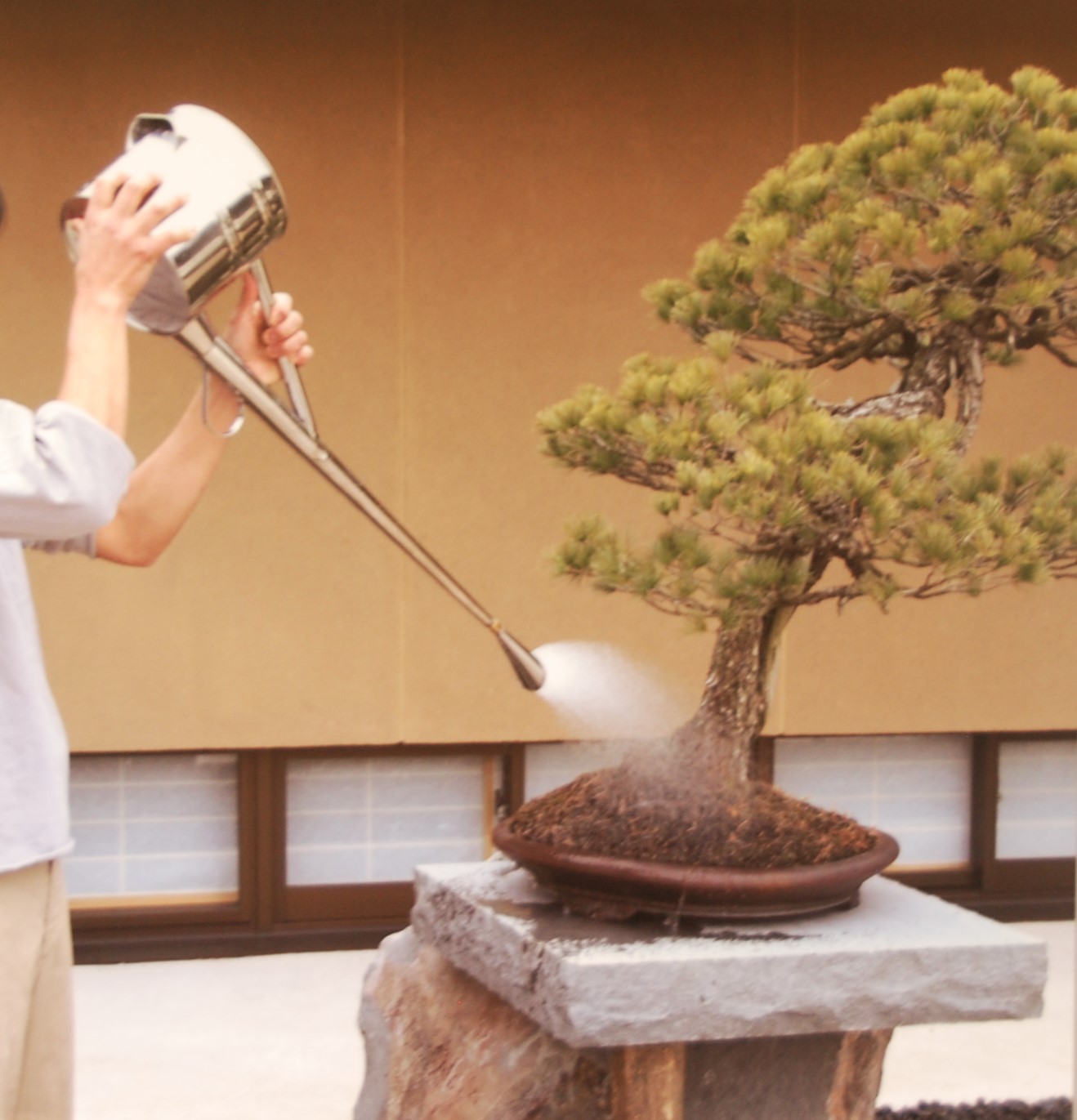As a general guideline, you should water your bonsai tree 2 to 3 times a day in summer. This frequency may vary depending on the soil type, climate, tree species and their growth stage.
How often to water bonsai in summer
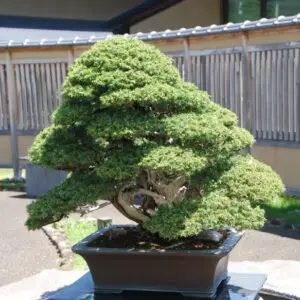
Needle juniper
One of the key factors in maintaining the health of your bonsai tree during the summer is finding the right watering frequency. Here are some essential guidelines to help you determine the optimal watering frequency for your bonsai tree.
General guideline
As a very general guideline,
if your tree is planted in a shallow bonsai pot. You need to observe your bonsai tree carefully and water them when the soil is half dry.
This general rule should be altered depending on the following factors:
- the soil in which your bonsai tree is planted,
- the climate of your region, and
- tree species and their growth stage.
Factors affecting the frequency of watering
Soil
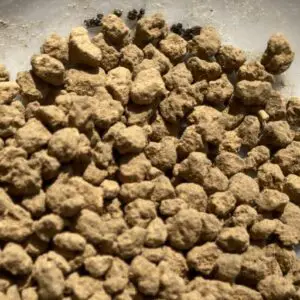
Akadama
The type of soil you use for your bonsai trees plays an important role in determining their water requirements. The soil composition affects the water retention and drainage, which directly impact how frequently and how much water your bonsai trees need.
The amount of soil in the pot is another important factor to consider. A larger volume of soil can retain more moisture, requiring less frequent watering compared to a smaller volume of soil, which may dry out more quickly.
If you are using a ready-to-use bonsai soil mix, check the ingredients on the package. Many products in the market contain a higher volume of tree bark or organic matter, which may retain moisture more than bonsai trees need.
Climate
The climate is another significant determining factor in the watering frequency of bonsai trees. Different climates have varying levels of temperature, humidity, and rainfall, which directly influence the water requirements of bonsai trees.
There are 5 major climate zones in the mainland US;

The major Köppen zones in the U.S.
(Source: National Weather Service)
-
- Zone A: tropical (Southern part of Florida)
- Zone B: dry (Arizona, Nevada, California)
- Zone C: moist subtropical mid-latitude (Florida, Georgia, Texas)
- Zone D: moist continental mid-latitude (New York, Pennsylvania, Michigan, Illinois
Oregon (coastal areas), Washington (coastal areas), and - Zone H: highlands climates.
Zone A: Tropical
- Southern part of Florida
The combination of warmth and moisture in the air can help maintain the soil moisture. It is important to monitor the moisture level of the soil and water as needed, as high humidity may lead to slower evaporation despite high temperatures.
Zone B: Dry
-
- Arizona
- Nevada
- Texas (small portions in the west)
- California
Bonsai trees in dry regions typically experience low humidity in summer. The lack of moisture in the air, coupled with high temperatures, can result in rapid evaporation and dry soil conditions.
Regular and frequent watering is crucial in summer to compensate for the low humidity in this zone.
I don’t think your trees will survive under full sun in summer if you are unable to check the soil moisture level during the day. You might have to move your trees to the shade or change the soil mixture that keeps more water (like adding more organic compost) next time repotting.
Zone C: Moist Subtropical Mid-Latitude
- Florida
- Georgia
- Texas
Bonsai trees in moist subtropical mid-latitude regions often experience moderate to high humidity levels in summer. The humid conditions can help retain moisture in the soil for a longer duration than dry areas.
Monitor the moisture level of the soil closely. Make sure to water your trees when the soil is half dry.
Higher humidity can be tricky sometimes because the soil surface may seem to be moist but inner soil can be dry when your trees absorb a lot of water under hot weather. On the contrary, the same higher humidity can prevent soil moisture from drying out and make it consistently saturated. You should thus be careful not to waterlog your trees as well.
Zone D: Moist Continental Mid-Latitude
-
- New York
- Pennsylvania
- Michigan
- Illinois
- Oregon (coastal areas)
- Washington (coastal areas)
- California (northern coastal regions)
Bonsai trees in moist continental mid-latitude regions typically experience moderate summers.
Monitor the moisture level of the soil and adjust the watering frequency depending on the temperature and the wind speed.
Your bonsai trees may not need much water at cool temperatures without wind but higher temperatures with wind may increase the rate of evaporation and soil moisture retention.
Species
Different species of bonsai trees have varying water needs. Some trees may require more frequent watering while others may tolerate drier conditions.
Though in general drought-tolerant species need less amount of water than water-loving trees, they still need water especially when they are growing. Remember that when you water bonsai trees, give them plenty so that water drains out of the bottom holes.
Under temperate climates in summer, you may need to water:
- 1 to 2 times a day for drought-tolerant species,
- 2 to 3 times a day for average species, and
- 3 times a day for water-loving species.
Here is the list of bonsai tree species and their water needs.
Bonsai tree species and water needs
Drought-tolerant
Pine species (such as black/white/red pine), Hinoki cypress
Slightly drought-tolerant
Persimmon, Chinese dade
Slightly drought-tolerant to moderate
Gardenia, camellia
Moderate
Ginkgo, maple, beech
Slightly water-loving
Japanese maple, cherry blossom, Japanese plum, Satsuki azalea, azalea, wild rose, cotoneaster, Chinese quince, Shimpaku juniper, needle juniper
Water-loving
Oak (Quercus dentata, Quercus serrata), birch, wisteria, Ezo spruce
For more information on the factors affecting watering frequency, please check the following post.
The best time of the day to water bonsai in summer
Choosing the right time of day to water your bonsai trees during the summer is crucial for their health and vitality. The timing of watering can significantly impact water absorption, minimize evaporation, and optimize overall hydration.
The best time of the day to water your bonsai trees in summer is early morning and late evening.
Early Morning
One of the optimal times to water your bonsai trees in summer is during the early morning hours. This is when temperatures are typically cooler and the sun is not yet at its peak intensity. Watering in the early morning allows the tree to absorb moisture before the heat of the day sets in.
It provides ample buffer for your trees to prepare for the high sun, reducing the risk of sunburn caused by extended periods of water shortage.
Late Evening
Another suitable time to water your bonsai trees in summer is in the late evening, close to sunset. By this time, the sun’s intensity has diminished and the surrounding temperatures begin to cool down. Watering in the late evening allows the tree to replenish its moisture levels overnight when water demand is lower.
Watering in the evening will also help cool the temperature inside the pot. Watering the leaves is effective, too, because it can lower the temperature of the leaves, remove dirt and dust, and restore tree vigor.
Avoid midday watering if you can
It is generally best to avoid watering your bonsai trees during the hottest part of the day, typically from late morning to early afternoon.
At this time, the sun is at its peak and temperatures are highest. Trees close stomata (holes at the back of leaves) to stop evaporation through leaves to prevent dehydration. Watering during midday may result in opening stomata (because it cools down trees), leading to further loss of moisture.
Also, the water may soon turn into hot water under the full sun, damaging the roots. Water on the leaves may act as lenses and burn the leaves as well.
That said, if you notice your trees are dehydrated, water them immediately. The number one cause of bonsai tree death in summer is water shortage. Dehydration will kill your tree quicker than you think.
Signs your bonsai needs water
Proper hydration is vital for the health and well-being of your bonsai tree, especially during the hot summer months when water requirements increase. So, it is important to be able to recognize the signs that indicate your bonsai tree needs water.
Here are some common signs to look for.
Dry soil

Feel the soil
One of the most obvious signs that your bonsai tree needs water is dry soil.
Check the moisture level of the soil regularly by lightly touching it. If the soil feels dry and hard to the touch, it is an indication that your tree is dehydrated and needs watering. Dry soil also looks whiter in color than moist soil. Mosses on the soil or weeds, if any, also look dry and white.
Look for gaps or the soil pulling away from the edge of the pot as well. As the soil dries out, it contracts and shrinks, creating gaps between the soil and the pot. When it does, it is a clear indication that your bonsai tree needs immediate watering.
Wilting leaves
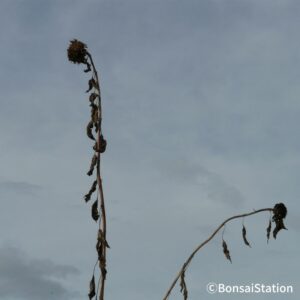
When a bonsai tree lacks sufficient water, its leaves may start to wilt and droop. The foliage may appear dull in color. Wilting leaves are a clear indication that your tree is under stress and in need of hydration. This is especially true for broad-leaf trees.
Coniferous trees, on the other hand, may not necessarily exhibit wilting leaves (needles). When they lack water, the tips may turn yellow or brown but this is a severe case of dehydration and you don’t want to wait that long to water them.
Lighter weight

Weighing by hand
Another way to check the moisture level is to measure its weight by lifting the pot.
For this, you should have prior knowledge of how much it weighs usually. Every time you look after your bonsai trees, you lift the bonsai pot. You would know, after doing it over and over, how much it weighs and when it feels lighter.
Preventing heatwave and drying out
Keeping your bonsai tree adequately hydrated during the summer is essential for its health and vitality. Heatwaves can pose significant challenges to the health and survival of your bonsai trees, which can easily kill them if unprepared.
The thermal death limit is around 115°F (46°C) for temperate zone trees like most bonsai species but the gravity of heat stress increases rapidly as the air temperature rises above 85°F (29°C).
Once temperatures reach the death limit, trees’ protein that makes up their cells starts to break down and they will eventually die.
There are several factors that influence bonsai trees’ heat tolerance, of which water content within their body is the most critical one.
If you want to know more about this topic, please read the following post.
So, it is crucial to take proactive measures to protect your bonsai trees during these extreme weather conditions. Fortunately, there are several strategies you can employ to prevent drying out and ensure your bonsai tree stays hydrated.
Consider the following techniques.
Sunshade

Providing shade (on the right)
Providing shade for your bonsai trees is crucial during heat waves. Direct sunlight can cause sunburn and excessive water loss through evaporation. Whenever a heat wave is expected, move your bonsai trees to a shaded area, such as under a tree or a covered patio as a precautionary measure.
Or, you can use shade cloth or create a temporary shade structure to shield the tree from intense sunlight. By reducing direct exposure to the sun, you can minimize water evaporation and help your bonsai tree retain moisture.
Mulching
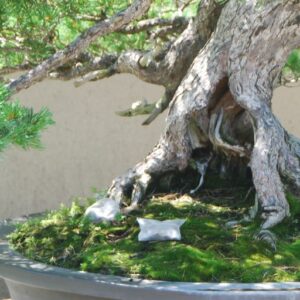
Applying moss or a layer of organic mulch around the base of your bonsai tree can help conserve moisture in the soil. Mulch acts as a protective barrier, reducing water evaporation.
Use materials such as bark chips to create a mulch layer about half an inch thick. This layer helps retain soil moisture, keeping the roots of your bonsai trees hydrated for longer periods.
Covering soil with moss can be a good option as well. Sphagnum moss can keep a lot of moisture but can retain too much of it if not applied carefully.
If you are wondering which moss to use, the following post might be helpful.
Wind protection
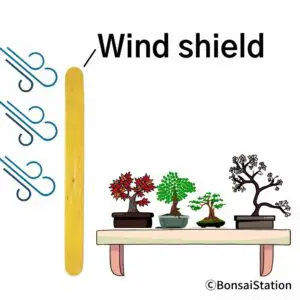
Windshield
Hot and strong winds can rapidly dry out the foliage and soil of your bonsai trees. If you live in an area prone to hot and dry winds, create windbreaks or shields to protect your trees.
You can place them near a wall, fence, or other plants that can help shield them from harmful winds. You can also use windbreak screens to provide further protection during heat waves.
Watering system
Preventing water shortage is the key to the survival of your bonsai trees during a heatwave. If you are unable to observe them and provide adequate water when necessary, you should have an additional system that keeps them moist during the day.

Bonsai trees buried in lava rocks
Use a box filled with lava rock or sand and bury the bottom of the pots in it. This system aims to increase the amount of soil to hold more water without repotting the bonsai trees to bigger pots and to get rid of it easily when it becomes unnecessary.
You may also consider using an automatic water timer to feed water to the box (not the trees) like the following one you can buy from Amazon. You can set the timer and you are good to go all day.
For more information about how to set up this system, please check the following post.
These strategies can help your bonsai trees withstand the challenging conditions of hot summers. You’ll give your bonsai trees the best chance of thriving even during extreme weather events.

